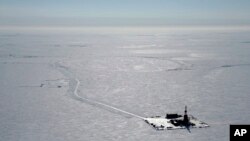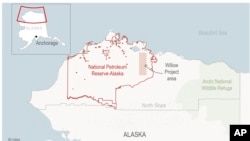U.S. President Joe Biden's administration on Monday announced it would approve a trimmed-down version of ConocoPhillips' Willow oil and gas drilling project in Alaska, triggering angry reactions from climate activists.
Here are some details about the project:
What is the Willow Project?
The Willow project is a $6 billion proposal from ConocoPhillips COP.N to drill oil and gas in Alaska. It would be located inside the National Petroleum Reserve-Alaska, a 23 million-acre (93 million-hectare) area on the state's North Slope that is the largest tract of undisturbed public land in the United States.
What was approved?
Biden's Interior Department on Monday approved a version of the project that would include three drill sites and less surface infrastructure than originally proposed. ConocoPhillips had initially wanted to build up to five drill sites, dozens of kilometers of roads, seven bridges and pipelines.
The Interior Department said the reduced scope of the project would help to reduce its impact on habitats for species like polar bears and yellow-billed loons.
The full project had been initially approved by the Trump administration years ago, but a federal judge in Alaska in 2021 reversed that decision, saying the environmental analysis was flawed and needed to be redone.
What is its environmental impact?
The Interior Department has emphasized the fact that it did not back the full proposal and only approved a trimmed-down version to reduce environmental risk. The agency also announced over the weekend it would remove other portions of the Arctic from future drilling leasing.
But environmental groups remain unhappy with the decision, arguing the project, even in its smaller form, conflicts with the Biden administration’s promises to fight climate change and poses a threat to pristine wilderness.
ConocoPhillips has said the trimmed-down plan represents "a viable path forward" for Willow and that it was ready to begin construction immediately upon approval.
Why is Willow important for Alaska?
The Willow project area holds an estimated 600 million barrels of oil, or more than the amount currently held in the U.S. Strategic Petroleum Reserve, the country's emergency supply.
The project is important to Alaska's elected officials, who are hoping it will help offset oil production declines in a state whose economy relies heavily on the drilling industry.
ConocoPhillips has said the project would deliver up to $17 billion in revenue for federal and state governments and local Alaska communities.
The Biden administration has also been urging U.S. oil companies to invest in boosting production to help keep consumer energy prices in check.







